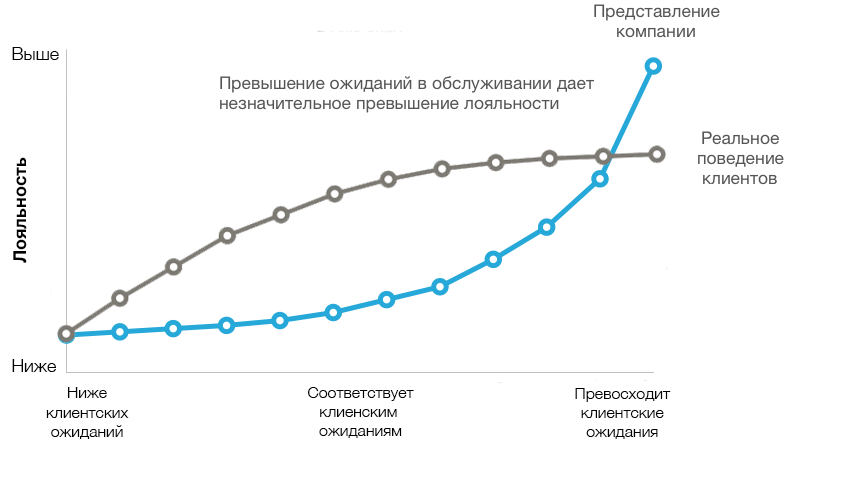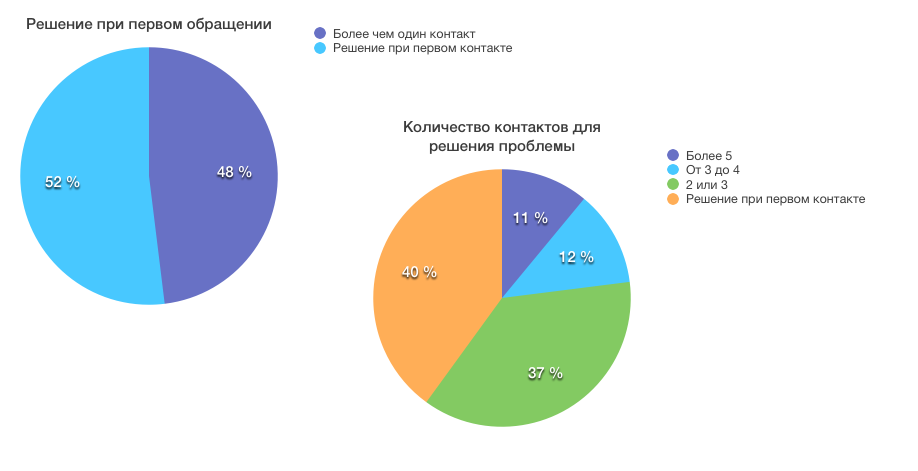3 myths about customer support
We recently met a study by Corporate Executive Board Co. experts who interviewed 400 companies and 90,000 customers to find out what quality service really means and how to achieve it. We will share with you some of the findings of researchers who refute most of the generally accepted notions. Forget everything you knew about service support before.
What a myth. Service should be outstanding, every time you need to jump above your head. 83% of executives believe that superior service leads to loyalty.

Where did it come from. Shelves burst from the books “excellent service”, “towards customers”, “customer forever yours”, where the strategy to surprise the customer is presented as the only true one. The trend of quality service is set by the giants' wow-cases: you must have heard the story of a giraffe vacation in Joshi Ritz Carlton or how Morton's restaurant delivered a steak directly to the airport at the request of a client on Twitter. One after another, services appear that rely on the service as the main advantage among competitors.
True.The best is the enemy of the good. In fact, the race for the ideal exhausts and empties the wallet of companies. In Ritz Carlton, every employee has the right to spend $ 2,000 to help a client if something goes wrong. But only a few companies can afford it. Dear employees, training programs, integrated systems, discounts, compensation - expenses for “outstanding” services grow by surveys to 20% and are not worth the profit that discouraged customers will bring.

Cases of genuine admiration are very rare and cannot be a regular occurrence, 84% of the clients surveyed say that the expectations were not only not exceeded, but were not justified. According to the study, customers most of all need problems to be resolved effortlessly. Moreover, there is virtually no economic difference between customers who are faced with outstanding service and those whose expectations were simply met.
What a myth. To meet customer expectations means to solve the problem the first time. Therefore, if most customers receive an answer to their question when they first contact, companies consider that the support service is effective.
Where did it come from. The easiest way to find a figure reflecting the quality of the contact center is to divide the number of calls resolved the first time by the number of all calls. Interviewed companies had an average FCR of 76.7% - that is, the problems of 77 out of 100 customers were resolved on the first call or letter. Not bad, but what if the customers ask the same question?

True.Only 40% of the lucky ones answered that they needed only one contact with the company to solve the problem. Why is there such a discrepancy between company data and real customer experience? Researchers consider the main mistake of companies that they take into account only direct problems formulated by the client. But after the client hangs up, he may have additional questions. Let's say the client specified whether the payment was successful, you answered yes, everything is in order. It seems to be answered the first time. However, the customer calls back and asks - when will the goods be delivered? You answer again, now you have two checkmarks in the statistics, but for the client these are related questions and he needed to call you twice to get an answer.
Researchers advise companies to look at the client’s question as an event, rather than an isolated problem, to take into account the associated, hidden problems, so as not to force customers to turn again. The more efforts a client spends on a solution, the less satisfied he is, even if he receives the right answer for each individual question.
What a myth. There should be many communication channels: telephone, mail, skype, twitter, contact, facebook.
Where did it come from. Companies believe that in doing so they give the client freedom: he chooses and appeals, as he is comfortable. 80% of the companies surveyed are planning to add new communication channels to the site in the near future.
True.A paradox is working: the abundance of choice fetters the client and it is more difficult for him to make a decision. 84% of customers prefer a simple solution to a problem, rather than the freedom to contact you via Skype or Twitter. This does not mean that you should deprive the client of freedom of choice at all, but the researchers recommend “lead the client by the hand”. Researchers give an interesting example of Lynksys, where they completely abandoned e-mail, finding out that the cost of it is 2 times higher and the effectiveness of solutions 2 times lower than by phone.
It’s best to tell the client which channels are effective in solving his particular problem. You can get an answer to a standard question in the chat, and a more complex problem with a lot of details and clarifications should be discussed by phone.
In order to work through several channels, you need to be able to at least for each: monitor problems, save a history of calls, keep statistics. Often companies simply don’t have a tool for this. We at Usedesk have added the ability to chat with customers on Twitter, Facebook and Contact. A message on the wall or a private message falls into Usedesk and the specialist processes it as a normal request. This will help to avoid forwarding the client from one channel to another, the answer on Facebook “write to us by mail” - your client will no longer see.
Share in the comments what myths about quality service you encountered and which metrics you consider useless.
1. Exceeding expectations
What a myth. Service should be outstanding, every time you need to jump above your head. 83% of executives believe that superior service leads to loyalty.

Where did it come from. Shelves burst from the books “excellent service”, “towards customers”, “customer forever yours”, where the strategy to surprise the customer is presented as the only true one. The trend of quality service is set by the giants' wow-cases: you must have heard the story of a giraffe vacation in Joshi Ritz Carlton or how Morton's restaurant delivered a steak directly to the airport at the request of a client on Twitter. One after another, services appear that rely on the service as the main advantage among competitors.
True.The best is the enemy of the good. In fact, the race for the ideal exhausts and empties the wallet of companies. In Ritz Carlton, every employee has the right to spend $ 2,000 to help a client if something goes wrong. But only a few companies can afford it. Dear employees, training programs, integrated systems, discounts, compensation - expenses for “outstanding” services grow by surveys to 20% and are not worth the profit that discouraged customers will bring.

Cases of genuine admiration are very rare and cannot be a regular occurrence, 84% of the clients surveyed say that the expectations were not only not exceeded, but were not justified. According to the study, customers most of all need problems to be resolved effortlessly. Moreover, there is virtually no economic difference between customers who are faced with outstanding service and those whose expectations were simply met.
2. FCR as the ultimate truth
What a myth. To meet customer expectations means to solve the problem the first time. Therefore, if most customers receive an answer to their question when they first contact, companies consider that the support service is effective.
Where did it come from. The easiest way to find a figure reflecting the quality of the contact center is to divide the number of calls resolved the first time by the number of all calls. Interviewed companies had an average FCR of 76.7% - that is, the problems of 77 out of 100 customers were resolved on the first call or letter. Not bad, but what if the customers ask the same question?

True.Only 40% of the lucky ones answered that they needed only one contact with the company to solve the problem. Why is there such a discrepancy between company data and real customer experience? Researchers consider the main mistake of companies that they take into account only direct problems formulated by the client. But after the client hangs up, he may have additional questions. Let's say the client specified whether the payment was successful, you answered yes, everything is in order. It seems to be answered the first time. However, the customer calls back and asks - when will the goods be delivered? You answer again, now you have two checkmarks in the statistics, but for the client these are related questions and he needed to call you twice to get an answer.
Researchers advise companies to look at the client’s question as an event, rather than an isolated problem, to take into account the associated, hidden problems, so as not to force customers to turn again. The more efforts a client spends on a solution, the less satisfied he is, even if he receives the right answer for each individual question.
3. Multichannel
What a myth. There should be many communication channels: telephone, mail, skype, twitter, contact, facebook.
Where did it come from. Companies believe that in doing so they give the client freedom: he chooses and appeals, as he is comfortable. 80% of the companies surveyed are planning to add new communication channels to the site in the near future.
True.A paradox is working: the abundance of choice fetters the client and it is more difficult for him to make a decision. 84% of customers prefer a simple solution to a problem, rather than the freedom to contact you via Skype or Twitter. This does not mean that you should deprive the client of freedom of choice at all, but the researchers recommend “lead the client by the hand”. Researchers give an interesting example of Lynksys, where they completely abandoned e-mail, finding out that the cost of it is 2 times higher and the effectiveness of solutions 2 times lower than by phone.
It’s best to tell the client which channels are effective in solving his particular problem. You can get an answer to a standard question in the chat, and a more complex problem with a lot of details and clarifications should be discussed by phone.
In order to work through several channels, you need to be able to at least for each: monitor problems, save a history of calls, keep statistics. Often companies simply don’t have a tool for this. We at Usedesk have added the ability to chat with customers on Twitter, Facebook and Contact. A message on the wall or a private message falls into Usedesk and the specialist processes it as a normal request. This will help to avoid forwarding the client from one channel to another, the answer on Facebook “write to us by mail” - your client will no longer see.
Share in the comments what myths about quality service you encountered and which metrics you consider useless.
